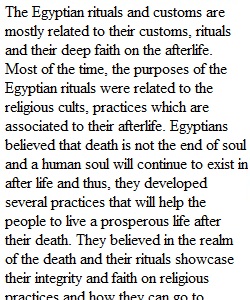


Q Building specification: Must survive eternity. In this essay, you will consider ancient Egyptian preparation for the afterlife, specifically with regard to tomb construction and tomb contents. To prepare for this activity, do the following: 1. Complete the text readings assigned for this module. 2. Watch the following segment on "Religious Cults and the Afterlife (Links to an external site.)" [Video, 05:56 minutes] from the film "Ancient Egypt." 3. From your readings, the film, and any optional outside research, compose a short essay (two pages of double-spaced text) regarding Egyptian burial, which integrates art into religious practices. For examples of tombs, use one of the Great Pyramids of Old Kingdom Egypt, and also the tomb of Tutankhamen of New Kingdom Egypt. Consider the religious conception of afterlife for the ancient Egyptians. What material preparations were necessary for the deceased in terms of tomb structure and contents? Address the following in your essay: • Why did the dead need material goods and mummification? • Consider how the differing tombs were designed to protect the deceased. • What types of objects were buried with Tutankhamen's mummy? Describe a few items to convey the wealth and artistry of these objects. Essay Writing Requirements: 1. Double-space 2. Two pages or 500+ words 3. Follow the APA style. 4. Proofread: Be sure to check your work and correct any spelling or grammatical errors before you post it. 5. Submit the essay to the assignment dropbox. 6. Grammar assistance is available using the Online Writing Lab (Links to an external site.) (OWL). 7. Submit the paper by the due date. Compose your work in a .doc or .docx file type using a word processor (such as Microsoft Word, etc.) and save it frequently to your computer. For those assignments that are not written essays and require uploading images or PowerPoint slides, please follow uploading guidelines provided by your instructor. Check your work and correct any spelling or grammatical errors. When you are ready to submit your work, click “Upload Submission.” Enter the submission title and then click on “Select a file to upload.” Browse your computer, and select your file. Click “Open” and verify the correct file name has appeared next to Submission File. Click on “Continue.” Confirm submission is correct and then click on “Accept Submission & Save.” Turnitin® This course has Turnitin® fully integrated into the course dropbox. This means that you should only submit your assignments to the dropbox below. Please do not submit your assignment directly to Turnitin.com. Once submitted, your assignment will be evaluated by Turnitin® automatically. You will be able to view an Originality Report within minutes of your first submission that will show how much of your work has been identified as similar to other sources such as websites, textbooks, or other student papers. Use your Originality Report as a learning tool to identify areas of your assignment that you may not have cited appropriately. You may resubmit your assignment through this dropbox as many times as you need to check to see if you have made improvements, until the due date of the assignment. However, once you have made your first submission, you will need to wait 24 hours after each subsequent submission to receive a new Originality Report. Plan accordingly as you draft your assignment. Once the due date has passed, your assignment submission will be considered final. Evaluation This assignment will be graded using the Written Assignment Grading Rubric located on the Rubrics page within the Start Here section of the course. Please review the rubric prior to beginning your work so that you ensure your submission meets the criteria in place for this assignment. This assignment is worth 30% of your final course grade.
View Related Questions